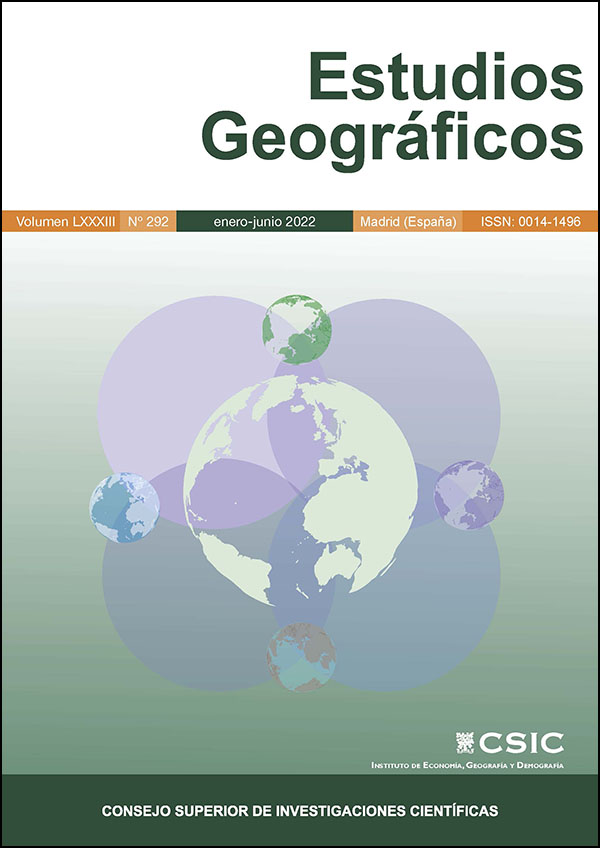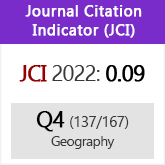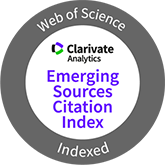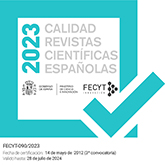Excepcionalidad agrícola, trabajadores agrícolas migrantes y la pandemia - evidencia de Polonia como nuevo país de destino de inmigrantes
DOI:
https://doi.org/10.3989/estgeogr.2022116.116Palabras clave:
Polonia, migración estacional, migración desde Ucrania, pandemia de COVID-19, agricultura, gobernanza de la migraciónResumen
Este artículo, basado en el trabajo de campo etnográfico que los autores realizaron entre los trabajadores agrícolas migrantes estacionales en Polonia, analiza el impacto de las soluciones de vía rápida del COVID-19 adoptadas en el sector sobre la situación general de los trabajadores agrícolas migrantes en la agricultura. Basados en la evidencia del campo así como en el análisis de políticas realizado en los últimos meses, argumentamos que las soluciones de vía rápida y las exenciones adoptadas en Polonia (como en muchos de los estados miembros de la UE) durante la pandemia de 2020-2021 no son únicas, sino que manifiestan la política de excepcionalismo agrícola de larga data. Esto tiene implicaciones prácticas sobre la salud y la seguridad de los trabajadores agrícolas migrantes y, paradójicamente, puede traducirse en un empeoramiento de sus condiciones de trabajo y de vida en las explotaciones. En este contexto, queremos arrojar luz sobre las dificultades de los trabajadores agrícolas durante la pandemia, para comprender mejor su posición, que resulta de la intersección de factores que aumentan las vulnerabilidades de los trabajadores agrícolas (temporalidades, aislamiento, baja sindicalización, intensificación del trabajo). Para comprender mejor el impacto de las soluciones especiales en el fenómeno del trabajo estacional, es necesario tener en cuenta la perspectiva de los empresarios. En conjunto, estas observaciones nos permiten trazar un cuadro más completo de la situación de los trabajadores agrícolas durante la pandemia en Polonia, un nuevo país de destino de inmigrantes.
Descargas
Citas
Bieniecki, M., and Pawlak, M. (2009). Strategie przetrwania. Adaptacja ukraińskich migrantów zarobkowych do polskiej rzeczywistości Instytucjonalnej. Skrót raportu. Badania, Ekspertyzy, Rekomendacje. Warsaw: Institute of Public Affairs.
Brunarska, Z., Kindler, M., Szulecka, M., and Toruńczyk-Ruiz, S. (2016). Ukrainian Migration to Poland: A "Local" Mobility? In O. Fedyuk and M. Kindler (Eds.), Ukrainian Migration to the European Union: Lessons from Migration Studies (pp. 115-131). Springer International Publishing. https://doi.org/10.1007/978-3-319-41776-9_7
Charlton, D., and Castillo, M. (2021). Potential Impacts of a Pandemic on the US Farm Labor Market. Applied Economic Perspectives and Policy, 43(1), 39-57. https://doi.org/10.1002/aepp.13105 PMid:33230406 PMCid:PMC7675323
Corrado, A., and Palumbo, L. (2022). Essential Farmworkers and the Pandemic Crisis: Migrant Labour Conditions, and Legal and Political Responses in Italy and Spain. In A. Triandafyllidou (Ed.), Migration and Pandemics. Spaces of Solidarity and Spaces of Exception (pp. 145-166). Cham, Switzerland: Springer. https://doi.org/10.1007/978-3-030-81210-2_8
Daugbjerg, C., and Feindt, P. H. (2017). Post-exceptionalism in public policy: Transforming food and agricultural policy. Journal of European Public Policy, 24(11), 1565-1584. https://doi.org/10.1080/13501763.2017.1334081
Duszczyk, M., Lesińska, M., Szczepański, M., Stefańska, R., and Szulecka, M. (2010). Polityka migracyjna w Polsce oraz jej wpływ na napływ i osiedlanie się imigrantów. In A. Górny, I. Grabowska-Lusińska, M. Lesińska, and M. Okólski (Eds.), Transformacja nieoczywista. Polska jako kraj imigracji (pp. 69-124). Warszawa: Wydawnictwa. Uniwersytetu Warszawskiego.
Eurostat. (2021). First residence permits visualised. (n.d.). Retrieved 21 March 2022, from https://ec.europa.eu/eurostat/de/web/products-eurostat-news/-/wdn-20211102-1
Fiałkowska, K., and Matuszczyk, K. (2020). Essential hands for work. CMR Spotlight, 12(18).
Fiałkowska, K., and Matuszczyk, K. (2021). Safe and fruitful? Structural vulnerabilities in the experience of seasonal migrant workers in agriculture in Germany and Poland. Safety Science, 139, 105275. https://doi.org/10.1016/j.ssci.2021.105275
Florczak, I. (2020). Pandemia COVID-19 jako papierek lakmusowy sytuacji migrantów ekonomicznych z krajów trzecich na polskim rynku pracy. Władza Sądzenia, 18, 63-77.
Frelak, J. (2011). Cudzoziemcy zatrudnieni przy pracach rolniczych. In W. Klaus (Ed.), Ziemia obiecana? Warunki pracy cudzoziemców w Polsce (pp. 127-146). Warsaw, Poland: Stowarzyszenie Interwencji Prawnej.
Górny, A., and Kaczmarczyk, P. (2018). A known but uncertain path: The role of foreign labour in Polish agriculture, Journal of Rural Studies, 64, 177-188. https://doi.org/10.1016/j.jrurstud.2017.12.015
Górny, A., and Kaczmarczyk, P. (2020). Temporary farmworkers and migration transition: On a changing role of the agricultural sector in international labour migration to Poland. In J. F. Rye and K. O'Reilly (Eds.), International Labour Migration to Europe's Rural Regions (pp. 86-103). London, United Kingdom: Routledge. https://doi.org/10.4324/9781003022367-7
Górny, A., and Kindler, M. (2018). Cudzoziemcy w Polsce na przełomie XX i XXI wieku. In. M. Lesińska and M. Okólski (Eds.), 25 wykładów o migracjach (pp. 221-234). Warsaw, Poland: Wydawnictwo Naukowe Scholar.
Górny, A., Kaczmarczyk, P., Fiałkowska, K., Piechowska, M., and Szulecka, M. (2016). Imigranci z Ukrainy w Polsce. Raport z badania. Warszawa: OBMF.
Górny, A., Kaczmarczyk, P., Szulecka, M., Bitner, M., Okólski, M., Siedlecka, U., and Stefańczyk, A. (2018). Imigranci w Polsce w kontekście uproszczonej procedury zatrudniania cudzoziemców. WISE-Europa, Ośrodek Badań nad Migracjami UW. http://www.migracje.uw.edu.pl/wp-content/uploads/2016/11/raport-power.pdf
Haley, E., Caxaj, S., George, G., Hennebry, J., Martell, E., and McLaughlin, J. (2020). Migrant Farmworkers Face Heightened Vulnerabilities During COVID-19. Journal of Agriculture, Food Systems, and Community Development, 9(3), 35-39. https://doi.org/10.5304/jafscd.2020.093.016
Holt, E. (2021). COVID-19 vaccination in Ukraine. The Lancet Infectious Disease, 21, 462. https://doi.org/10.1016/S1473-3099(21)00156-0 PMid:33773128
Iglicka, K., and Gmaj, K. (2013). Circular Migration Patterns between Ukraine and Poland. In A. Triandafyllidou (Ed.), Circular Migration between Europe and Its Neighbourhood: Choice or Necessity (pp. 166-187). Oxford, United Kingdom: Oxford University Press. https://doi.org/10.1093/acprof:oso/9780199674510.003.0008
Keryk, M. (2021). Does Polish Origin Matter? The Integration Challenges of Polish Card Holders in Poland. Ethnopolitics, 20(1), 123-135. https://doi.org/10.1080/17449057.2020.1808330
Klaus, W. (2021). The Porous Border Woven with Prejudices and Economic Interests. Polish Border Admission Practices in the Time of COVID-19. Social Sciences, 10(11), 435. https://doi.org/10.3390/socsci10110435
Kurs, T. (2020). Rekord zakażeń koronawirusem na Mazurach. Obcokrajowcy nauczyli się omijać kwarantannę. gazeta.pl. https://olsztyn.wyborcza.pl/olsztyn/7,48726,26149251,17-zakazen-koronawirusem-na-mazurach-obcokrajowcy-nauczyli.html
Liebman, A. K., and Augustave, W. (2010). Agricultural health and safety: Incorporating the worker perspective. Journal of Agromedicine, 15(3), 192-199. https://doi.org/10.1080/1059924X.2010.486333 PMid:20665305
McAreavey, R. (2017). New immigration destinations: Migrating to rural and peripheral areas. London, United Kingdom: Routledge. https://doi.org/10.1201/9780415540056
Minister do nauczycieli: Idźcie do pracy w polu zbierać truskawki! (2020, May 25). Głos Nauczycielski. https://glos.pl/minister-do-nauczycieli-idzcie-do-pracy-w-polu-zbierac-truskawki
Molinero-Gerbeau, Y. (2021). The Problem is not Covid-19, it's the Model! Industrial Agriculture and Migrant Farm Labour in the EU. EuroChoices, 20(3), 69-74. https://doi.org/10.1111/1746-692X.12308 PMCid:PMC8209881
MRiRW, GIS. (2020). Wytyczne MRiRW i GIS dla producentów rolnych zatrudniających cudzoziemców przy pracach sezonowych w związku z rozprzestrzenianiem się SARS-CoV-2.
MRPiT, Departament Rynku Pracy. (2021). Informacja o zatrudnieniu cudzoziemców w Polsce. https://psz.praca.gov.pl/web/urzad-pracy/-/8180234-informacje-o-zatrudnieniu-cudzoziemcow-w-polsce
Neef, A. (2020). Legal and social protection for migrant farm workers: Lessons from COVID-19. Agriculture and Human Values, 37(3), 641-642. https://doi.org/10.1007/s10460-020-10086-w PMid:32836741 PMCid:PMC7235435
Nowicka, M., Bartig, S., Schwass, T., and Matuszczyk, K. (2021). COVID-19 Pandemic and Resilience of the Transnational Home-Based Elder Care System between Poland and Germany. Journal of Aging and Social Policy, 33(4-5), 474-492. https://doi.org/10.1080/08959420.2021.1927615 PMid:34016033
OECD. (2019). International Migration Outlook 2019. OECD Publishing. https://doi.org/10.1787/c3e35eec-en
OECD. (2020). International Migration Outlook 2020. OECD Publishing. https://read.oecd-ilibrary.org/social-issues-migration-health/international-migration-outlook-2020_ec98f531-en
Okólski, M. (2021). The Migration Transition in Poland. Central and Eastern European Migration Review, 10(2), 151-169.
Papademetriou, D. G., and Hooper, K. (2020). Commentary: How is COVID-19 Reshaping Labour Migration? International Migration, 58(4), 259-262. https://doi.org/10.1111/imig.12748
Plewa, P. (2007). The Rise and Fall of Temporary Foreign Worker Policies: Lessons for Poland 1. International Migration, 45(2), 3-36. https://doi.org/10.1111/j.1468-2435.2007.00402.x
Puślecki, D., and Lipińska, I. (2009). Wypadkowość przy pracy w rolnictwie na tle wybranych krajów zachodnioeuropejskich. Roczniki Naukowe Stowarzyszenia Ekonomistów Rolnictwa i Agrobiznesu, XI(5), 258-263.
Stachowski, J., and Fiałkowska, K. (2020). 'Living on the edge'?: A comparative study of processes of marginalisation among Polish migrants in rural Germany and Norway. In J. F. Rye and K. O'Reilly (Eds.), International Labour Migration to Europe's Rural Regions (pp. 104-120). London, United Kingdom: Routledge. https://doi.org/10.4324/9781003022367-8
Szulecka, M. (2016). Paradoxes of formal social control. Criminological aspects of foreigners' access to the Polish territory and labour market. Biuletyn Polskiego Towarzystwa Kryminologicznego Im. Prof. Stanisława Batawii, 23, 79-95.
Tagliacozzo, S., Pisacane, L., and Kilkey, M. (2021). The interplay between structural and systemic vulnerability during the COVID-19 pandemic: Migrant agricultural workers in informal settlements in Southern Italy. Journal of Ethnic and Migration Studies, 47(9), 1903-1921. https://doi.org/10.1080/1369183X.2020.1857230
Tymczuk, A. (2021). Bringing the Virus Back Home: Media Representations of Ukrainian Labour Migrants in a Time of Pandemic. East European Politics and Societies, 36(3), 913-934. https://doi.org/10.1177/08883254211018770
Vitkauskaitė-Ramanauskienė, J. (2020). Policy Exceptionalism: Analysis of ideational framework governing agricultural sector in Lithuania. Viešoji Politika Ir Administravimas, 19(3), 86-101. https://doi.org/10.5755/j01.ppaa.19.3.26320
Wiśniewski Ł., and Rudnicki, R. (2016). Labour Input in Polish Agriculture Against Size of Agricultural Holdings - Spatial Analysis. Journal of Agribusiness and Rural Development, 3(41), 413-424. https://doi.org/10.17306/JARD.2016.69
Wolska, A. (2020, March 27). Koronawirus: Ukraina całkowicie zamyka granice. Czy także dla własnych obywateli? www.euractiv.pl. https://www.euractiv.pl/section/polityka-zagraniczna-ue/news/koronawirus-ukraina-calkowicie-zamyka-granice-czy-takze-dla-wlasnych-obywateli/
Legal acts
Directive 2014/36/EU of the European Parliament and of the Council of 26 February 2014 on the conditions of entry and stay of third-country nationals for the purpose of employment as seasonal workers (OJ L 94, 28.3.2014, p. 375-390).
Rozporządzenie Ministra Pracy i Polityki Społecznej z dnia 21 kwietnia 2015 r. w sprawie przypadków, w których powierzenie wykonywania pracy cudzoziemcowi na terytorium Rzeczypospolitej Polskiej jest dopuszczalne bez konieczności uzyskania zezwolenia na pracę (Dz. U. poz. 588).
Rozporządzenie Ministra Spraw Wewnętrznych i Administracji z dnia 13 marca 2020 r. w sprawie czasowego zawieszenia lub ograniczenia ruchu granicznego na określonych przejściach granicznych (Dz. U. poz. 435 z późn. zm.).
Ustawa z dnia 20 kwietnia 2004 r. o promocji zatrudnienia i instytucjach rynku pracy (t.j. Dz. U. z 2021 r. poz. 1100 z późn. zm.).
Ustawa z dnia 2 marca 2020 r. o szczególnych rozwiązaniach związanych z zapobieganiem, przeciwdziałaniem i zwalczaniem COVID-19, innych chorób zakaźnych oraz wywołanych nimi sytuacji kryzysowych (t.j. Dz. U. poz. 1842 z późn. zm.).
Ustawa z dnia 7 września 2007 r. o Karcie Polaka (t.j. Dz. U. z 2019 r. poz. 1598).
Publicado
Cómo citar
Número
Sección
Licencia
Derechos de autor 2022 Consejo Superior de Investigaciones Científicas (CSIC)

Esta obra está bajo una licencia internacional Creative Commons Atribución 4.0.
© CSIC. Los originales publicados en las ediciones impresa y electrónica de esta Revista son propiedad del Consejo Superior de Investigaciones Científicas, siendo necesario citar la procedencia en cualquier reproducción parcial o total.Salvo indicación contraria, todos los contenidos de la edición electrónica se distribuyen bajo una licencia de uso y distribución “Creative Commons Reconocimiento 4.0 Internacional ” (CC BY 4.0). Puede consultar desde aquí la versión informativa y el texto legal de la licencia. Esta circunstancia ha de hacerse constar expresamente de esta forma cuando sea necesario.
No se autoriza el depósito en repositorios, páginas web personales o similares de cualquier otra versión distinta a la publicada por el editor.
Datos de los fondos
Norges Forskningsråd
Números de la subvención 261854/F10
















